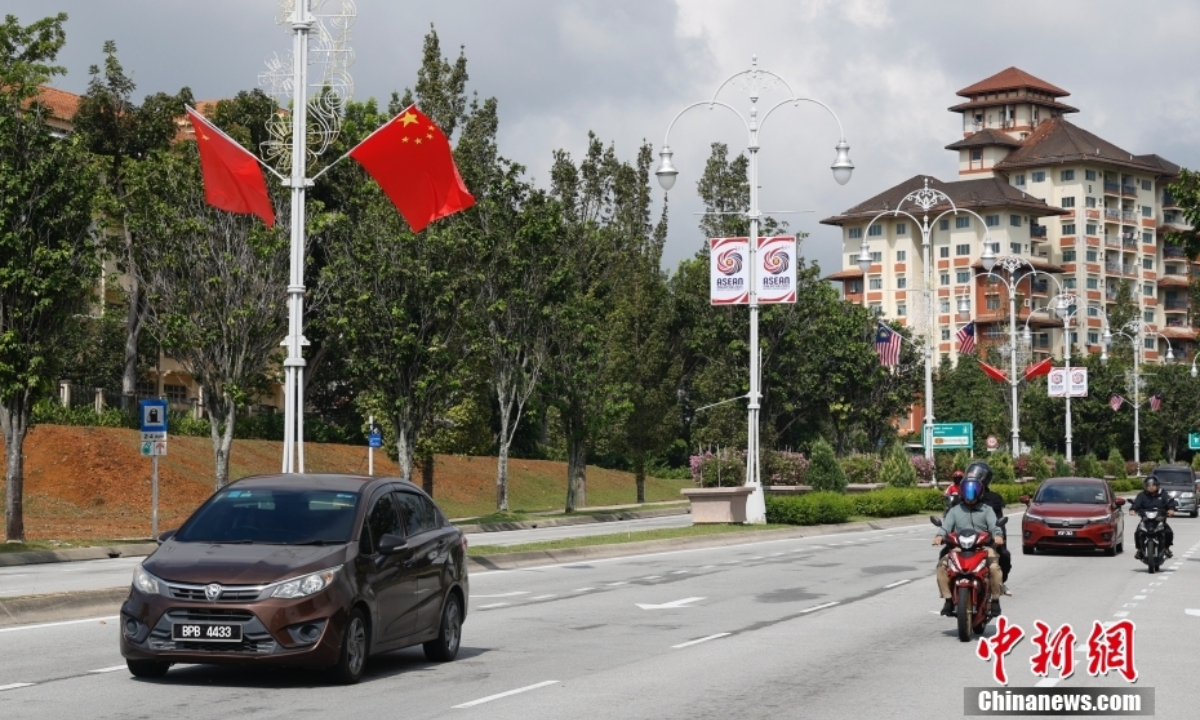
Photo: China News Service
As Chinese President Xi Jinping is scheduled to pay a state visit to Malaysia, the warm welcome and great anticipation for the trip is palpable on some streets of the Malaysian capital of Kuala Lumpur and in interviews with local residents from all walks of life.
In his first overseas trip of the year, Xi is visiting Vietnam, Malaysia and Cambodia from Monday to Friday, according to the Xinhua News Agency. Xi's visit to Malaysia will be his second in 12 years, which marks an important milestone in promoting the upgrading of the relations between China and Malaysia, according to the Chinese Foreign Ministry.
The anticipation for the Chinese President's arrival was visible on one of the main streets of Kuala Lumpur on Monday. At a section of the Jalan Tun Razak, China's five-starred red flag, alongside the Malaysian national flag, was flying high over heavy traffic on Monday afternoon.
"This is definitely a major event. This is President Xi's first visit to Malaysia in many years, so there is a lot of excitement," a taxi driver surnamed Zheng told the Global Times early on Monday morning, adding that the Malaysian side pays great attention to the visit.
The state visit was also in the headlines of major Malaysian media outlets. "It will certainly be the country's most high-profile visit by a foreign head of state," Bernama, Malaysia's official news agency, said in a report on Sunday, adding that the visit marks a major milestone in China-Malaysia relations.
The news agency also reported in a separate article that the visit has sparked high hopes it will further deepen stronger ties and boost high-value investment technological cooperation.
Close ties, win-win cooperationIn Kuala Lumpur, many are quick to point the long history of exchanges between the two countries that started centuries ago with the voyages of renowned Chinese navigator Zheng He as well as the mutually beneficial cooperation the two countries have carried out in recent years.
The Global Times has visited several places around the Malaysian capital that offered vivid testaments to the close ties and win-win cooperation between the two countries.
On a Sunny morning, as temperatures started to heat up, students were rushing to classrooms for their morning classes at the Xiamen University Malaysia. Inside a huge classroom, students were starting to settling in for their lecture on principles of management.
"Students from China account for around one-third of the total. Most students are from Malaysia, and we have students from many other countries," an official at Xiamen University Malaysia told the Global Times, adding business courses are the most popular among students.
During his 2013 visit to Malaysia, Xi witnessed the signing of an agreement on establishing a Malaysian branch of Xiamen University, the first overseas campus of a Chinese higher education institute, according to Xinhua.
Since then, it has seen remarkable achievements - since enrollment started in 2016, more than 6,300 students have graduated from the school and it currently has more than 9,100 students from 48 countries and regions, according to the People's Daily.
The success of Xiamen University Malaysia offers a prime example of the ever-growing people-to-people and cultural exchanges between China and Malaysia, given the specifical relationship Xiamen University has with Malaysia. Based in East China's Fujian Province, the university was established in 1921 by Tan Kah Kee, a patriotic overseas Chinese businessman and philanthropist, who was born in Xiamen and achieved great business success in Malaysia and Singapore, according to Xinhua.
Today, the Malaysian branch of Xiamen University has become a top choice for many students from countries in Southeast Asia and beyond, facilitating exchanges and talent training on a regional and global level.
"I chose to study here because Xiamen University Malaysia provides world-class education. I was really excited about studying in a multicultural environment," Tsydypova Ianzhid, a student at Xiamen University Malaysia from Russia who majors in e-commerce, told the Global Times.
Beyond the campus of Xiamen University Malaysia, there are also plenty of other signs of close cooperation between China and Malaysia.
From many parts of Kuala Lumpur, a106-story tall skyscraper with a blue body and white top in the downtown region is hard to miss. With a height of 452 meters, the Exchange 106 Tower is one of the tallest buildings in not just Malaysia but in Southeast Asia. From the outside, it looks like many scrappers in this vibrant city; however, a closer look would reveal its closer ties to China.
Apart from its well-known Chinese tenants including Huawei, the building in itself is built by Chinese State Construction Engineering Corp (CSCEC).
"This is the tallest building that has ever been built by a Chinese firm in the overseas market," Huang Yidong, vice general manager of Malaysia Main Branch of CSCEC, told the Global Times, while viewing various technical and other breakthroughs.
Among the highlights that gained widespread attention in Malaysia is the speed at which the building was completed - with a contract duration of just 31 months, according to Huang. "Because of the location, many people can see the daily progress of the construction, so many people actually paid great attention. And many of them think this is truly unbelievable," he said.
Beyond the shocking speed and various features of the building, Huang also repeatedly pointed to one crucial aspect of the construction of the building - cooperation with local partners and the hiring of local workers. "We are focused on win-win cooperation, in heeding calls from the two countries," Huang said, adding many local firms and workers have continued to work with the firm on other projects.
Tan Kean Wei, a Malaysian national who has been working at CSCEC's branch in Malaysia for seven years, also told the Global Times that the Chinese firm not only brought world-class technology and management to the country, but has actually focused on localization that offers opportunities for locals.
And with top-level exchanges between the leaders of the two countries, there will be even more opportunities.
"I believe that this visit will not only boost our economy, but will also create many opportunities, such as job opportunities, increase our technical skills and also enhance our whole industry," Tan said, referring to the visit of the Chinese leader.




